Calculus BC (more like BS)
1/76
There's no tags or description
Looks like no tags are added yet.
Name | Mastery | Learn | Test | Matching | Spaced |
|---|
No study sessions yet.
77 Terms
total distance vs distance vs distance
total distance = ∫√(dx/dt² + dy/dt²) dt
distance = √(y-distance)² + (x-distance)²
distance = ∫ v(t) dt
Disk
washer
shell
v = π∫ba (f(x)² dx
π∫(top - AOR)² - (bottom - AOR)² dx
v = 2π∫ height (x)
For shell, x is x - the distance from revolution axis ex. | _ _ x would be (x-2)
Disk/washer = perpendicular rectangle
Shell = parallel rectangle
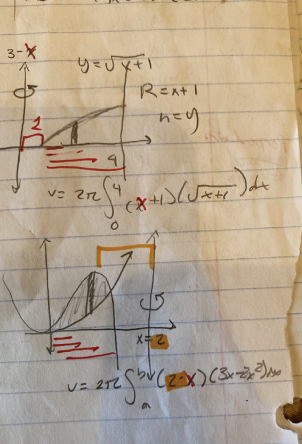
x and y for polar curves
slope for polar curve
area
x = rcosθ
y = rsinθ
y/x = tanθ
y/x is slope
1/2∫ f(θ)² dθ
between curves = ½ ∫(R²-r²) dθ
eulers method
y = y current + deltax( dy/dx)
e^x maclaurin
e^x = Σ x^n / n! = 1 + x + x² / 2! + x³ / 3! + …
sin(x) maclaurin
Σ (-1)^n x^(2n+1) / (2n+1)!
= x - x³ /3! + x^5/5!
cos(x) maclaurin
Σ (-1)^n x^(2n) / (2n)!
= 1 + x²/2! + x^4/4! -
ln (1+x) maclaurin
Σ (-1)^(n+1) x^n / n
= x - x²/2 + x³/3
convergence at -1 < x < 1
1/(1-x) maclaurin
Σx^n = 1+ x + x² + x³ . . .
convergence at |x|<1
what to do when given a maclurin where you need to substitute
u = lsdfkjsdlkf
and substitute like you would with intergration
Errors legrange and alternating series
boundaries of how big the error wil be
the error is always smaller than the next term
Alternating serires: error is less than the next term after the one. you are “summed”
bn HAS TO BE decreasing, negative, and lim n—>∞ = 0
check if you’re using the right formula

Rose curves
n petals when n is odd
2n petals when n is even
t = a cos (nø) —> reflectable against x axis
t = a sin (nø) —> reflectable against y-axis
petals are as long as “a”
leminscute
a rose curve basically but only 2
r² = a²sin(2ø)
if a² it /
if a² it is \
r² = a²cos(2ø)
if a² it’s —-
if -a² |
a is how long each curve is
circles
r=acosø
if a is pos, directed right
if a is neg, directed left
r=asinø
if a is pos, goes up
if a is neg, goes down
a is the diameterli
limacon
r = a+- bsinθ
if b is pos, opens up, if b is neg opens down
r = a +- b cos
if b is pos, opens right, if b is neg opens left
**opens means where the majority of the mass is
When a/b <1 —> has an inner loop that’s b-a long
each “bump” is a long, length is a + b (NOT INCLUDING THE BUMP)
When a/b = 1 —> cardiod (the heartshaped one)
each “bump” is a long, length is a + b (NOT INCLUDING THE BUMP)
no inner loop
When 1 < a/b < 2 —> dimpled limison (kind of heart shaped but doesnt curve in as much
each “bump” is a long, length is a + b (NOT INCLUDING THE BUMP)
no inner loop
When a/b > 2 —> dimpled limison
no inner loop
each “bump” is a long, length is a + b (NOT INCLUDING THE BUMP)
basically a circle with a flat edge
First thing you check (no actual solve)
Divergence test
if lim n→∞ ≠ 0, than it diverges
if it does = 0, than inconclusive
Obvious ratio in format a(ratio) ^n-1
actual solve
geometric series
∑ ar^(n-1)
if |r| < 1 than converges to a/(1-r) **a is the first term, r is the common ratio that you get by dividing any an+1/an
if |r| ≥ 1, than diverges
quick converge or diverge when you see 1/n^p or or (1/n)^p
p-series test
1/n^p
if p>1, converges
if p ≤ 1, diverges
looks like something we know
no facorials but like 1/(n²+1)
comparison test
a(n)<b(n)
if the bigger converges, the smaller converges
if smaller diverges, bigger diverges
1/(nln(n)) diverges
looks like something we know but a bit more confusing
limit comparison test
lim n→∞ (small/big) = C
if c is finite positive number: both an and bn converge OR both diverge
alternating / conditional convergence
if an is convergent and |an| is convergent, it’s called absolute convergence
if it’s not convergent when you’re doing |an|, it’s not absolutely convergent
if alternating series
Alternating series test
if it’s alternating, lim n→∞ = 0, decreasing
converges
(messy stuff) ^n
lim n→ ∞ n√a(n)
Root Test
if L<1 then absolute convergence
if L>1 or = ∞ than diverges
if L=1 than use another test
if it looks intergratable
intergral test
conditional: positive, continuous, and decreasing
if intergral converges, than the an converges
if intergral diverges, than an diverges
factorials
ratio test - remember it’s absolute value
L = lim n—>∞ |an+1/ an|
if L< 1 converges absolutely
if L>1 diverges
if L=1 use a diff test
can’t just take out factorials though like
(n+2)!/(n+1)! = n+2
also can’t just take out constants that loo like they’re with the n
ex. usually just auto take out everything except for the -1 and x, but in this case there was a 3^1
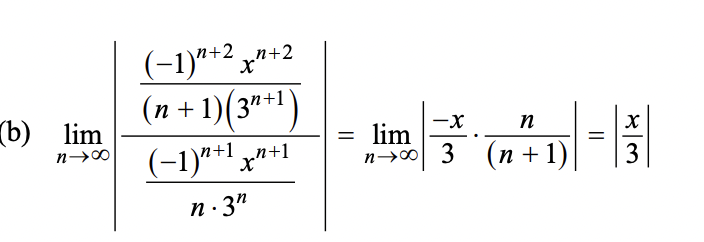
reimans sum using ∫an and Σ
figure out what the common theme is and what the ∆x is because reimans sum is ∆x * f(∆x)
then you’d plug in only f(x) into an intergral and use ∆x to find the boundaries (a and b)
intergral of convergence
remember when the x is based around something you alater the intergral of convergence
check for brackets or parenthesis
this doesn’t only apply to ratio test
ex. an(x-3)^n is convergent at x=5, this means we know interval of convergence is AT LEAST 1<x<5 HOWEVER we don’t know for sure the other interval that we guessed (in this case x=1) is FOR SURE convergent ALWAYS TESTTT
arc length
S = ∫ √( 1+(f’x)² ) dx
typically you’d have to combine the 1+(f’x)² into one fraction and then take out the denominator bcs it has an exponent
applying L’hopitals to limits
must prove l’hoptials exists first
ln both sides and switch the ln&limit
make the fraction a denominator, and apply l’hoptials until you can simplify it down to lny=constant
y = e^constant
Compounding continuously
A = Ce^(rt)
compounding noncontinuously based on year
A = C(1+r/n)^(nt)
C = initial deposit
n is based on the time unit, ex if it’s year n=1, if it’s month n=12
Logistical Growth Equation
dy/dx = Ky(1-y/L)
y = L(1+be^(-Kt)
L is largest value (carrying capacity)
K is the constant of perpetuality ( K is pos/neg depending if function is increasing/decreasing)
b (find what this is using y(0) )
Halfway is the fastest growing point
i think both graphs look the same (for dy/dx and y)
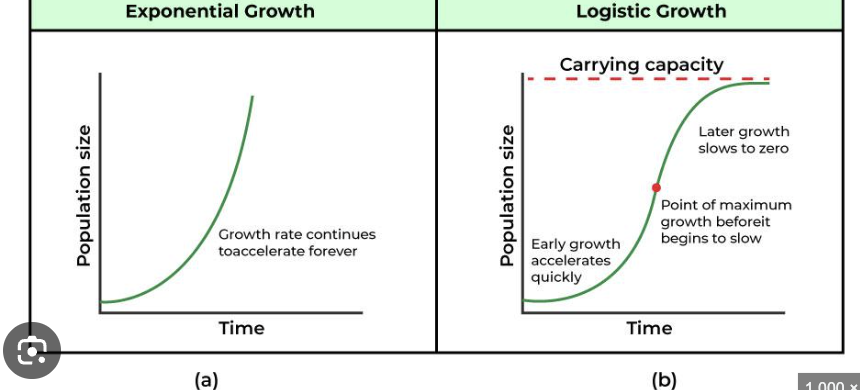
LIATE
uv - ∫vdu
Use the table to see if you need to keep on going
don’t forget the +C or the boundaries
seperation of variables
put the +C on the x side, solve for the C RIGHT AFTER intergrating
when 1/(4-y) remember u = 4-y, du = -dy YOU NEED TO ADD THE - SIGN
slope fields
0 slope is ←→
undefined slope is | d
∫a^u du
derivative of a^u
a^u / lna + C
ln(a)a^u
∫du/√(a² -u²)
arcsin u/a +C
∫du/u√(a² -u²)
1/a arc sec |u|/a+C
∫du/ (a² + u²)
1/a arctan u/a +C
∫tan u
-ln |cosu| +Cf
∫sec u
ln |sec u + tan u|
∫cot u
ln |sinu|+C
∫cscu
-ln|cscu + cotu| +C
∫1/(1+e^x)
∫1+e^x / 1+ e^x - e^x / 1+e^x
bcs 1 + e^x - e^x = 1
sin² x
1 -cos2x / 2
cos²x
1+cos2x / 2
trig substituition
substitute the “x” into the √
plug in the du as well
after intergrating find ø using triangle
√(a²-x²)
x = a sin ø
√(a²+x²)
x = a tanø
√(x²-a²)
x = a secø
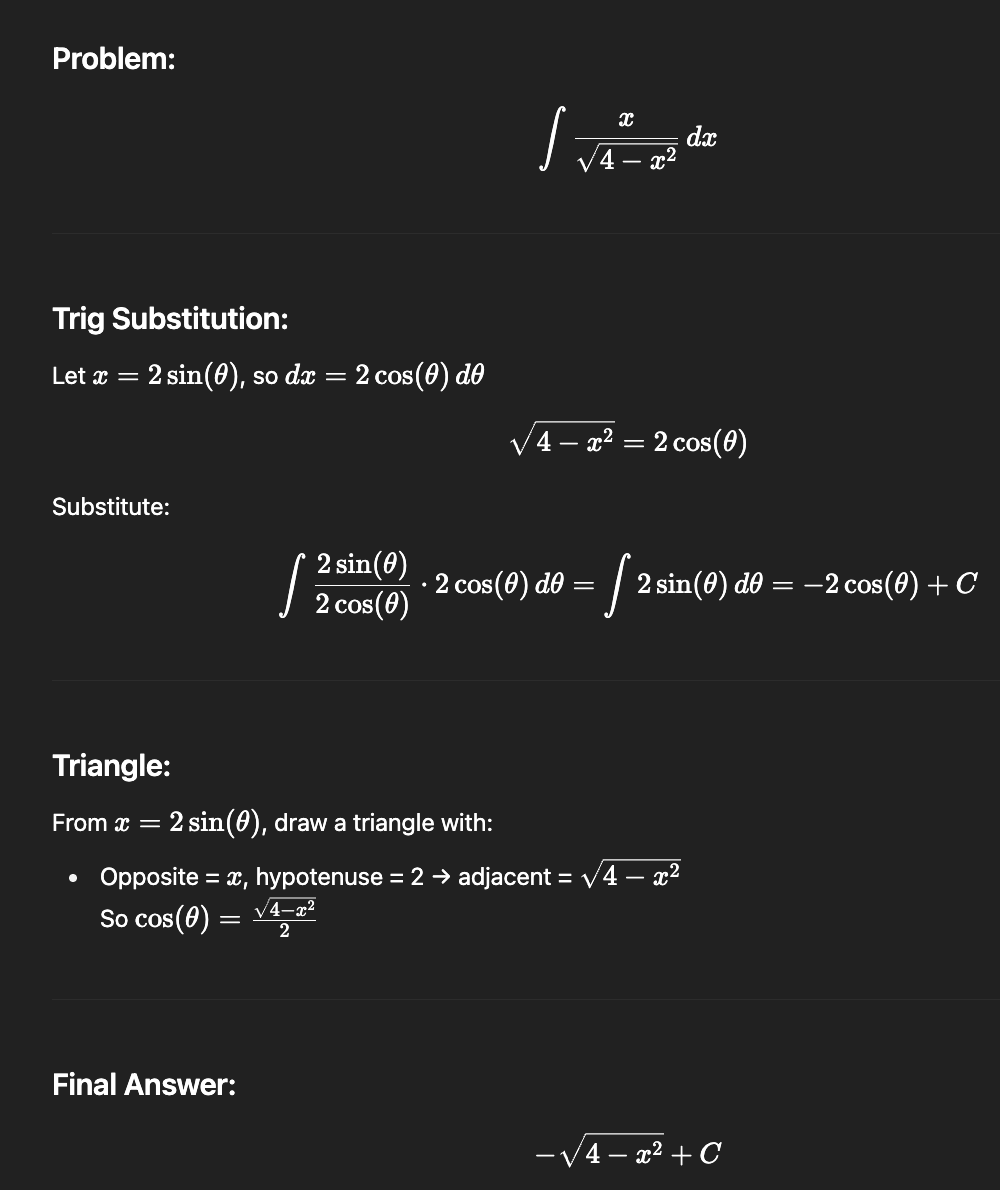
if n is even ∫π/2 cos^n (x) dx
if n is odd ∫π/2 0 cos^n (x) dx
remmember cos and sin are interchangeable here

odd : (2/3) (4/5) (n-1)/n)
even : (π/2) (1/2) (3/4) (n-1)/n)
infinity intergrals
split into ∫∞ o and ∫o -∞
AND
lim b—>∞ ∫b a
inconsistencies intergrals
you have to split it to where the inconsistency is
ex. ∫2 -2 (1/x)
= ∫2 0 (1/x) + ∫0 -2 (1/x)
MVT
continuous differentialble
if point c in an open interval f’c equals average rate of change
trapezoidal rule
(b-a)/2n [f(x0) + 2 (fx1) + . . . f(xn)]
b-a is ∆x
only works if they’re all the same ∆x
More standard ver: (a+b / 2) (n)
limn→∞ sigma [F(b-1)i/n ] (b-a / n)
Σ c= cn
Σ i = n(n+1)/2
Σ i² = n(n+1)(2n+1)/6
Σ i³ = n² (n+1)² /4
replace x with the ∆x/n **remember that the one inside f(x) has an i as well
take out the ∆x /n on the outside of the limit because it’s just a constant
Seperate sigma notation until i is isolated into one of the formulas above and the constants are isolated (there should be no n’s as of now INSIDE the sigma notation)
no more sigma notation, simplify n until you can use a/b rule to find what the area is equal to (remember to multiply the earlier ∆x/n back in)
when a/b have the same exponents that’s what A is equal to
Area of Surface Area
2π∫ y * (√1+(y’(x))²) dx
horizontal asymptote
num<den y = 0
num = den a/n coefficients
num > den no asymptotes
slant asymptote
an +1 / an
divide using long division, and ignore whatever the remainder is, what you calculated is the asymptote
to find vertical column of water with cross section of 3
∫3*density
boundaries are the heights
two critcal points means what
no where does f’(x) = 0
1/ln(n+1) and 1/n
1/ ln(n+1) > 1/nsl
distance formula
for f(x) when it’s less than what’s given f’x
f(d) = ∫g(x) from b —> a
f(d) = f(b) - f(a)
-f(a) = f(b) - f(d)
f(a)= F(d) - F(b)
average value formula
1/b-a ∫f(x) dx
whenever it says absolute maximum or minimum
use the end points as well no matter what
whenever you get a limit with absolute value
use the left/right limit, not l’hopitals
which grow faster logarithms or polynomials
polynomials
logarithms growth is significantly slower compared to polynomials.
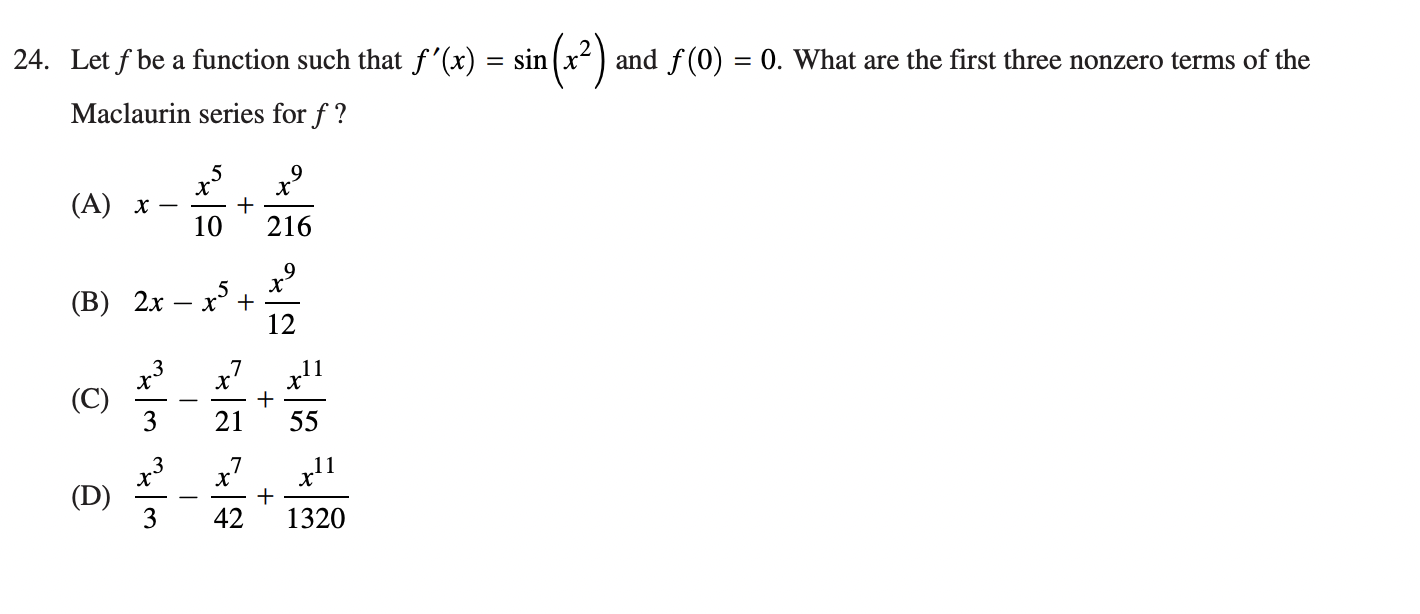
how would you go about solving this
find the f’(x) macluarin first and then intergrate each individual term, just like how’d you do if it was asking for the derivative

d) because it’d change too many times
average value vs rate
∫ vs f(x) -f(x) / x2-x1
when there’s a line of sorts what to pay attention to when it’s asking for the max/min
when it starts (not always at t=0)
evt check for all of the endpoints+crits
IVT
continuous
if f(a)<k<f(b) there’s somewhere with f(p)=k
volume derivative questions
don’t plug in everything until you’re done deriving, especially if you can’t replace one variable with another (ex. h≠2r)
if one of the errors doesn’t tell you the term number
see what the f(x) equals too and then that’s what term it is
ex. |f(1/2) = 4|
Look for which term when you plug in ½ equals 4
Use the term after
if there’s a simple fraction and you NEED to find convergence
geometric series USE AS OFTEN AS YOU CAN WHENEVER
check EXACTLY what the question is asking for
like if you need to add 300seconds
deriving an intergral (1rst derivative rule)
usually what you do just replace the t with x or the other way around, but if there’s a -0.8t or something because it’s E(t) -L(t) , you would take the derivative of that as well
tbh just know what they’re aksing and what each formula represents because this question said that 0.7 people leave per second (which sounmds like rate but it would be in the total number of people in line not the rate equation)



what to do when you see a dø/dt or dø/dr or whawtever something confusing
figure out what d/d they’re asking for
figure out what d/d you have
figure out the d/d you need to multiply by/divide by to get the aswer ex. need dø/dt, have dr/dt, find dø/dr
derive it no matter what
